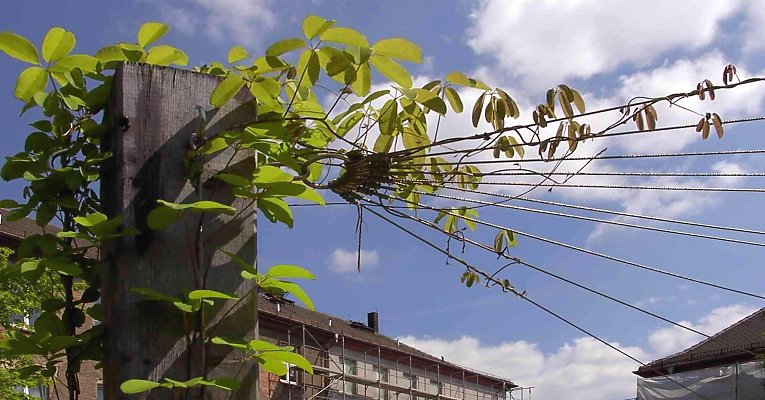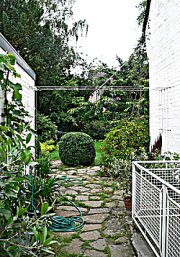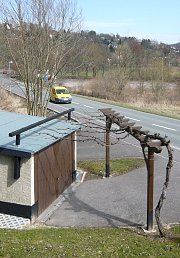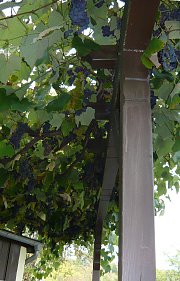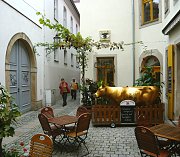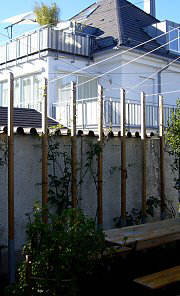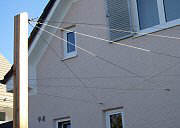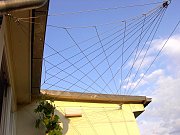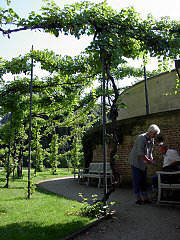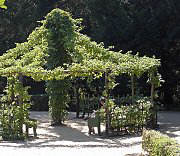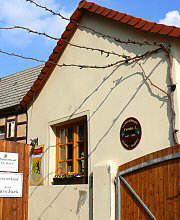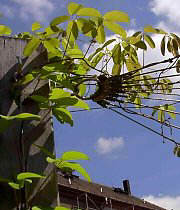A Roof of Green?
By guiding a climbing plant upwards and then horizontally on cables or steel mesh, you can create a garland of leaves, a delicate green canopy, or a denser 'roof' of greenery. While individual tension cables are sufficient for garlands, multiple cables are needed when you want to create a green roof. The weight of climbing plants increases with age, so this type of installation must be very solid from the start, especially if the green roof is stretched over a pergola. What should you be mindful of when creating your green roof? Which plants are most fitting? The following information and photo galleries are here to support you. Refer also to our section on pergolas.
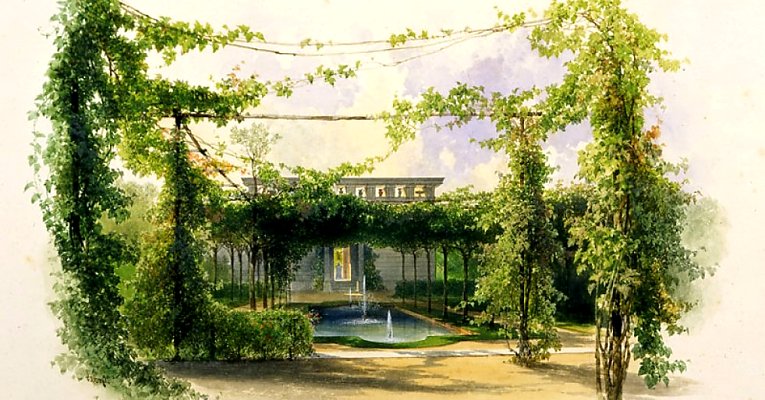
Suitable Climbing Plants
Grapevines are particularly suitable for green garlands, roofings, pergolas, balconies/canopies, etc.. This type of roof greening needs to be pruned regularly and should always remain airy/well ventilated to avoid mildew formation. For denser, opaque green roofs, go with Dutchman's pipe, akebia, or wild (grapeless) grapevines... expect a few years for them to create a really opaque green roof. Fast-growing annuals are perfect for garlands; they are lightweight, their foliage manageable, and with their branches dying off annually, they pose virtually no problems to the structure they are climbing. With vigorously twining plants like wisteria, bittersweet, silver lace (fleece) vine, and kiwi, it is essential to ensure that they don't become entwined with the wire ropes. Details for a parallel trellising of the stems/shoots can be found in our section on wisteria.
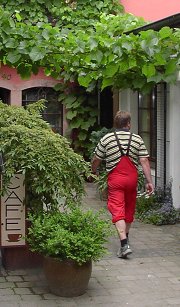
Greening of a courtyard with wild grapevines
Single and Parallel Strands (Garlands)
In the Baroque era of garden art, people began experimenting with hanging vine garlands, or "festoons." Later, after electrification, electric cables in rural areas were often routed through a courtyard and the associated strong tension rope was also used as a holding rope for a vineyard garland. (Farmers have always been enthusiastic about such practical things!) Whether cable and anchoring are suitable for such additional loads must be clarified in each individual case. Ropes were also often tensioned solely for climbing plants. FassadenGrün designed the system 0040 specifically for tensioning a cable between two buildings as a garland (through that link you can also find information about unusual structural features, etc..). With several parallel cables, the garlands can provide green canopies, even green roofs, between the walls. You can, of course, combine this suspended greenery with wire rope climbing fields on a facade.
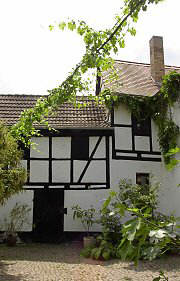
Grapevine on the wire of an electrical line
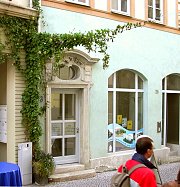
Green garlands with an annual cathedral bell vine
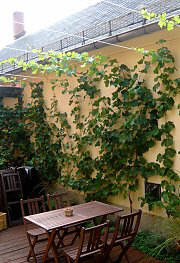
Vine garlands, similar to our cable system System 0040
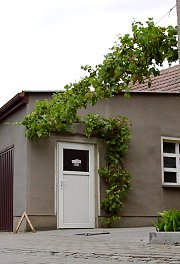
Two vine garlands: cables spanned one above the other, similar to our system System 0040
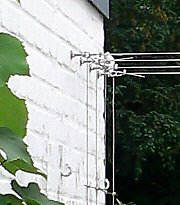
Climbing cables for an overhead greening, detail to the photo above; eye bolts affixed with composite mortar, WH 10150
Street Greening
In southern Europe, you'll find ample examples of green garlands hanging in the streets and alleys (in Freiburg / Germany, for example.) Unlike a courtyard greening, permits may be necessary with this type of greening, because it usually includes public road space. The liability for possible damage (for example: torn out tension ropes) should be clarified with the authorities; then nothing stands in the way of a road greening. The greenings will then usually be limited to narrow streets, alleys, and pedestrian zones. They can radically improve the ambience in these pedestrian areas.
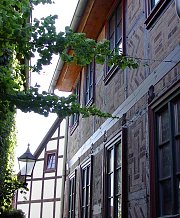
Greening of an alley with bittersweet
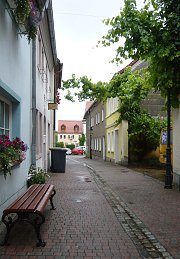
Overhead greening in an alleyway, grapevines
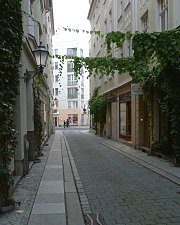
Street greening with Dutchman's pipe
Fan-shaped and Intersecting Strands
Modifcations to system 7060, such that intersecting rope compartments are created, can provide a load-bearing structure for the green roof. Plan the canopy (so, the cables) as high as possible to compensate for the inevitable sagging of the ropes from the weight of the plants. With the highest possible placement, the leaves and shoots will also be able to grow (often in their hanging habit) without disturbing the passageway or the heads underneath.
Points of distribution for the ropes can be placed on separate wooden supports (posts, pillars) as with wire frameworks; these posts must be sufficiently supported- for example, by tensioning cables anchored in the ground (as with cable system 0050) or by a support triangle when needed. If necessary, the posts can be anchored in a nearby wall with short tensioning ropes or stainless steel threaded rods (see photo). Installation in the upper part of the wall is only permitted if the upper bricks are held by a peripheral tie (ring) beam or an overlying heavy concrete roof slab; otherwise, they must be anchored more deeply. A separate permit may be required at property boundaries if customary fence heights are exceeded. If many ropes run from one point, then add rings with screw joints/links. Use cable with a maximum thickness of 3mm so that they can absorb peak loads rather than the support post.
Fan-shaped and cross-linked strands
Modifications of System 7060 with intersecting rope fans are particularly suitable for flat spans. Green canopies should be pulled up as high as possible, if only to allow and compensate for a certain amount of slack in the ropes. Also, leaves and shoots that hang downward can then unfold better and are less of a nuisance because there is still enough clearance.
Distribution points for the ropes are often placed on separate wooden supports as with wire frames, in which case the posts must be supported as with wire frames or braced into the ground in accordance with rope system 0050, if necessary also double with offset ropes (support triangle). If necessary, short tensioning ropes or stainless steel threaded rods can also be used to anchor the post to a wall behind it (see photo). Fixing at the top of the wall is only permissible if the upper stones are held in place by a ring anchor or an overlying, heavy concrete roof slab, otherwise fixing must be deeper. At property lines, separate approval may be required if local fence heights are exceeded.
If many ropes go from one point, rings with screw links should be installed. In any case, only 3 mm rope should be used so that the ropes remain the "weakest link" in the system and load peaks do not have too strong an effect on the posts.
